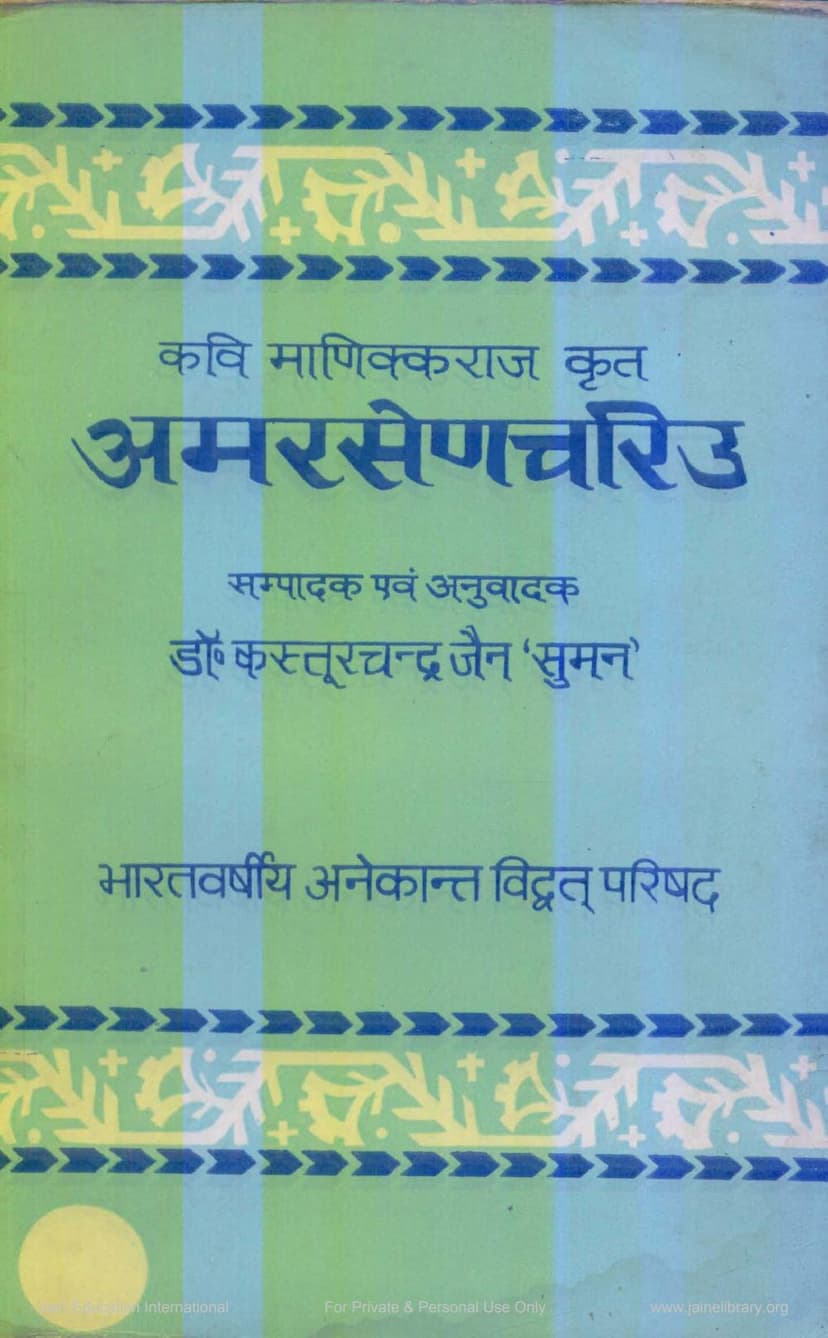Amarsenchariu
Added to library: September 1, 2025

Summary
This comprehensive summary is based on the provided Jain text, "Amarsenchariu" by Pandit Manikkaraj, compiled and translated by Dr. Kasturchand Jain 'Suman', and published by Bharat Varshiya Anekant Vidwat Parishad. The text is a significant work in Jain literature, offering profound insights into Jain philosophy, ethics, and narratives.
Book Title: Amarsenchariu Author: Pandit Manikkaraj Editor & Translator: Dr. Kasturchand Jain 'Suman' Publisher: Bharat Varshiya Anekant Vidwat Parishad
Overall Summary:
"Amarsenchariu" is a Jain text composed in Apabhramsa, a transitional language between Prakrit and modern Indian languages. The work is a narrative that delves into the lives and spiritual journeys of various characters, illustrating key Jain principles such as karma, reincarnation, dharma, adherence to vows, and the ultimate goal of moksha (liberation). The text is rich in philosophical discussions, ethical guidelines for both ascetics and laypeople, and a detailed portrayal of ancient Indian society, culture, and beliefs.
The narrative is structured into seven 'Sandhis' (sections), each comprising numerous 'Kadravaks' (stanzas or verses). The text is written in a 'Yamak-Pad' style, a poetic form that employs rhyming words at the end of verses, often within a structure known as 'Kadavak'. The language used is primarily Apabhramsa, interspersed with Sanskrit verses.
Key Themes and Teachings:
-
The Importance of Right Faith (Samyaktva): The text strongly emphasizes the foundational role of Samyaktva (right faith) in the Jain path to liberation. It highlights that without Samyaktva, even ascetic practices might not lead to salvation. The text details the twenty-five doshas (flaws) to be avoided and the eight angas (limbs) and eight gunas (virtues) to be cultivated.
-
Karma and Reincarnation: A central theme is the unwavering principle of karma and its inevitable consequences. The text illustrates how actions in this life determine future births and experiences across various realms (heaven, human, animal, hell). The narrative emphasizes that suffering and happiness are products of one's own karma, not external factors.
-
Ethical Conduct (Dharma): "Amarsenchariu" meticulously outlines the principles of ethical conduct, categorizing them for ascetics (Mahavratas) and lay followers (Anuvratas). It elaborates on the five vows: non-violence (ahimsa), truthfulness (satya), non-stealing (asteya), celibacy/chastity (brahmacharya), and non-possession/non-attachment (aparigraha). The text also details various prohibitions, such as avoiding twenty-two types of impure foods and thirty-two types of life-infesting substances.
-
The Pursuit of Knowledge and Liberation: The text consistently points towards the pursuit of right knowledge (samyak-gyan) and right conduct (samyak-charitra) as essential steps towards liberation. It celebrates the lives of great souls who achieved moksha through rigorous austerities, detachment, and deep meditation.
-
Social and Cultural Depiction: The work provides valuable glimpses into the social fabric of ancient India. It describes cities, lifestyles, the importance of family relationships, the roles of different professions (kings, ministers, merchants, artisans), and the pervasive influence of Jainism in societal norms. The text also touches upon the economic conditions and artistic expressions of the time.
-
Narrative Structure and Literary Style: Pandit Manikkaraj's narrative style is engaging, designed to maintain reader interest by weaving complex philosophical concepts into compelling stories. The use of Yamak-Pads and interspersing Sanskrit verses enhances the literary quality. The text's adherence to the Kadravak-Paddhati (a poetic structure) makes it a significant contribution to Apabhramsa literature.
Specific Characters and Narratives:
-
Dhanankara and Punnankara: The story often begins with discussions on the fruits of punya (merit) and papa (demerit). The lives of these two brothers are used to illustrate how even humble beginnings, coupled with devotion and adherence to dharma, can lead to auspicious rebirths and spiritual progress. Their aspiration for liberation and their eventual celestial birth after a pious end are highlighted.
-
Amarsena and Vairsena: These brothers, who were celestial beings in a previous birth, are central to the narrative. Their earthly journey involves royal life, challenges, deception, and ultimately, renunciation. Their story illustrates themes of royal duties, the impermanence of worldly pleasures, and the consequences of actions.
-
Raja Srenika and Gautam Ganadhara: The text often frames discussions through dialogues between King Srenika and Lord Mahavira's chief disciple, Gautam Ganadhara. These dialogues serve as a platform to explain Jain doctrines, such as the karmic destiny of a cowherd boy, the intricacies of Jain rituals, and the path to salvation.
-
Influence of Previous Lives: The concept of reincarnation and how past actions influence present lives is a recurring motif. Characters often recall their past births, providing lessons on the continuity of karma and the spiritual evolution of the soul.
-
Ethical Dilemmas and Solutions: The text presents characters facing moral dilemmas, such as the consequences of attachment, the dangers of greed, and the importance of righteousness. The narratives often conclude with characters learning from their mistakes and embracing the Jain path.
Literary and Historical Context:
- Language: The primary language is Apabhramsa, with some scholars noting the influence of the Bundeli dialect. This linguistic aspect makes the text valuable for studying the evolution of Indian languages.
- Manuscript: The manuscript was obtained from the Amer Shastra Bhandar of Shri Mahavirji, indicating its historical significance and preservation.
- Composition Period: The text's composition is estimated to be between Vikram Samvat 1498 and 1576. The specific mention of King Vikramaditya's era in dating inscriptions provides historical context.
- Inspirations: The author, Pandit Manikkaraj, was influenced by earlier Jain poets like Raudhu, as evidenced by similarities in descriptions of cities and religious practices.
Conclusion:
"Amarsenchariu" is not merely a collection of stories but a profound treatise that integrates philosophical teachings with captivating narratives. It serves as a guide for spiritual aspirants, emphasizing the interconnectedness of actions, destiny, and liberation, all within the framework of Jain principles. The text's rich literary style and detailed social commentary make it a valuable resource for understanding Jain tradition and ancient Indian culture.